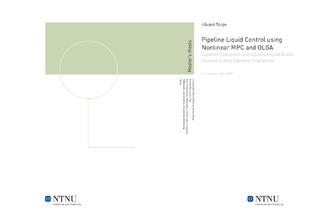Pipeline Liquid Control using Nonlinear MPC and OLGA: Optimal Utilization of Available Liquid Buffer Volume during Pipeline Transients
Master thesis
Permanent lenke
http://hdl.handle.net/11250/259843Utgivelsesdato
2007Metadata
Vis full innførselSamlinger
Sammendrag
Pipelines with multiphase flow will exhibit large and highly nonlinear liquid rates during transients caused by changes in production rate. This requires either a large separator (slug catcher) downstream, capable of handling all disturbances, or, some sort of control of the rate change in order to ensure that the downstream processing equipment can cope with the disturbances. In this report, it is proposed to use smart liquid control to optimally control the production during rate changes. The term smart liquid control was coined to describe the use of nonlinear model predictive control (NMPC) and a nonlinear pipeline model to control liquid levels. The pipeline from the Snøhvit field to the Hammerfest LNG plant was used as a test case on which to implement smart liquid control. The technique was proved using a simplified OLGA pipeline model for both predictions and as process, i.e. perfect model. Good results were shown, especially when compared to manual control. Smart liquid control therefore presents a possibility to reduce separator size for new projects. Another highly interesting use of smart liquid control is to optimize the use of separator buffer capacity in order to maximize production. The NMPC method used in this report, a single shooting multistep quasi-Newton method, was elaborated on in a literature review chapter. Also an implementation of the method was made and described in the context of NMPC. The implementation of the algorithm was made in the in-house STATOIL MPC-tool, SEPTIC. In order to assess the performance of the algorithm, it was tested on a small continuously stirred tank reactor system and the results reported and discussed.
